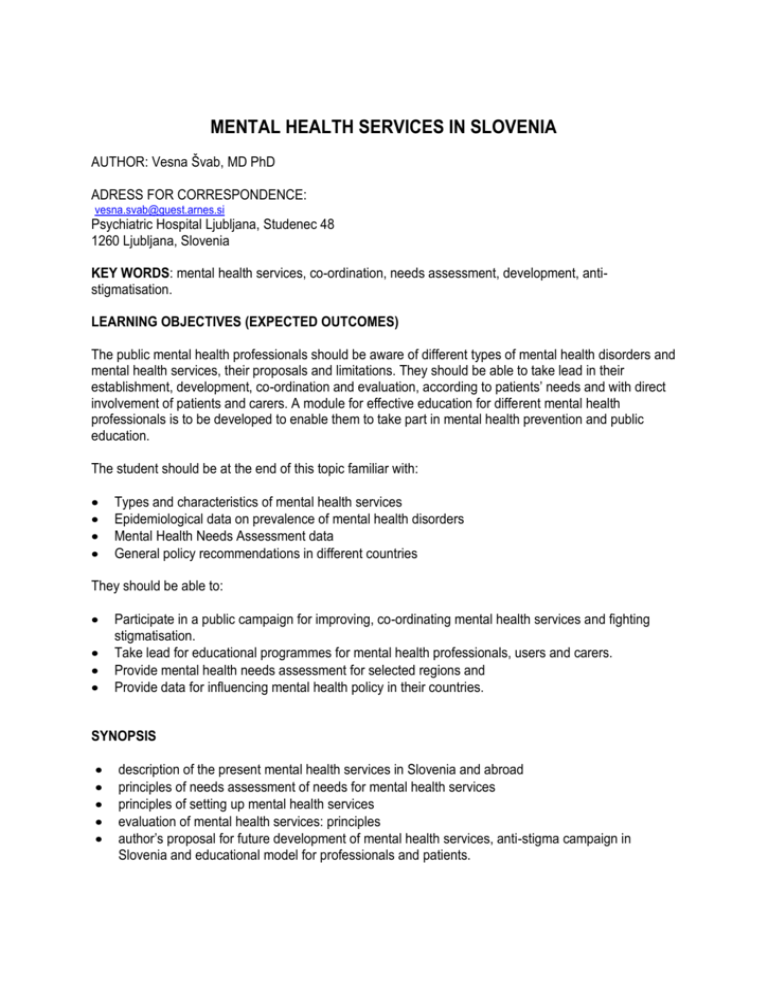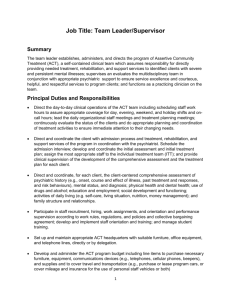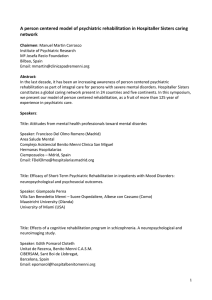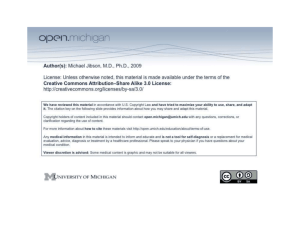MENTAL HEALTH SERVICES IN SLOVENIA
advertisement

MENTAL HEALTH SERVICES IN SLOVENIA AUTHOR: Vesna Švab, MD PhD ADRESS FOR CORRESPONDENCE: vesna.svab@guest.arnes.si Psychiatric Hospital Ljubljana, Studenec 48 1260 Ljubljana, Slovenia KEY WORDS: mental health services, co-ordination, needs assessment, development, antistigmatisation. LEARNING OBJECTIVES (EXPECTED OUTCOMES) The public mental health professionals should be aware of different types of mental health disorders and mental health services, their proposals and limitations. They should be able to take lead in their establishment, development, co-ordination and evaluation, according to patients’ needs and with direct involvement of patients and carers. A module for effective education for different mental health professionals is to be developed to enable them to take part in mental health prevention and public education. The student should be at the end of this topic familiar with: Types and characteristics of mental health services Epidemiological data on prevalence of mental health disorders Mental Health Needs Assessment data General policy recommendations in different countries They should be able to: Participate in a public campaign for improving, co-ordinating mental health services and fighting stigmatisation. Take lead for educational programmes for mental health professionals, users and carers. Provide mental health needs assessment for selected regions and Provide data for influencing mental health policy in their countries. SYNOPSIS description of the present mental health services in Slovenia and abroad principles of needs assessment of needs for mental health services principles of setting up mental health services evaluation of mental health services: principles author’s proposal for future development of mental health services, anti-stigma campaign in Slovenia and educational model for professionals and patients. TEACHING METHODS The recommended teaching method is: Literature search and study: mental health services; needs assessment; anti-stigma campaign. Collecting research data from available resources. Development of intranet web site for exchange of research results and discussion Exercise: preparation of recommendations for development of mental health services for selected regions Exercise: preparation of recommendations for anti-stigma campaign Preparing research modules for evaluation of mental health services and anti-stigma projects outcomes. Development of a web site for presentation of research results and recommendations (mental health report for selected regions). CONTENTS Introduction To reduce the number of psychiatric hospital beds in favour of community and outpatient services has become a standard policy in European countries, USA and Canada in the second half of last century. The main goals of mental health reforms were to develop a service system that is comprehensive, coordinated, accessible, acceptable, effective, efficient and accountable. The results of this process are still not thoroughly researched. In 50 years of moving patients out of state hospitals and putting them someplace else, mental health policy makers and practitioners remain all too myopically focused on the locus of care and treatment. Main questions to be answered about the development of mental health services today should be those examining their adequacy, quality, individualisation, and respectfulness of psychiatric care and treatment. In order to move away from ideologically directed decisions of reallocation of patients and from pure economic ones, the systems of care are to be adapted to local needs and conditions (1). The process of de-institutionalisation was carried out in very different ways. In some countries the process was optimally controlled and in others it has happened more chaotically. In the Netherlands government has developed a serial of documents with instructions to change existent mental health system to more flexible outpatient one with a range of services closer to the community. The idea was realised through regional institutes for outpatient care. The government took stand on providing also other alternatives to hospital treatment: day care, housing and assertive home treatment through nonprofit foundations. Since there was no shortening of hospital beds, the transformation of care took place more gradually than in other countries. It is proven that the substitution policy was successful to the extent that inpatient care was reduced and out-patient and other community care was increased (2). A very similar process has happened in Scandinavian countries (3) where hospital beds were gradually decreased parallel to development of community care services. Mental Health Services in Slovenia In Slovenia community psychiatric care for people with mental health disorders doesn’t have any legal basis. Mental heath services for people with severe mental disorders PSYCHIATRIC HOSPITALS Number of all psychiatric hospital beds is 1569, which means approximately 0,8 beds for 1000 inhabitants. Number of hospitalisations is slowly rising (6,4% in three years) and the length of hospitalisation is decreasing (1,72% in four years). Cost paid from the government for a patient per day is about 60 $, which provides all the living arrangements and treatment. Psychiatric hospitals are assigned to 9% of expenditure of all hospitals at the region. The University Psychiatric Hospital in Ljubljana covers a catachtment area with a population of nearly 700,000 inhabitants. Some of the hospital's specialised activities cover the whole of the population of Slovene. In 1999 a total of 3932 patients were admitted for hospitalisation. The same numbers were discharged. There is a small excess of admitted female patients over male patients (approximately 5 %). Among hospitalised patients there were 34 % persons with schizophrenic and paranoid disorders and 19 % with affective disorders. Addiction to alcohol, and its psychotic consequences, can be observed in as many as one third of all our patients. In 1999 50 % of patients were admitted for the first time, whereas 50% were repeating hospitalisation. The proportion of re-hospitalisation is slowly increasing. Slovene psychiatric hospitals provided easy access to treatment in hospital if necessary. Psychiatric departments did open most of the closed wards, but they didn’t abandon them. The number of beds in Slovenia remained 0,8 -1 bed/1000 inhabitants, which was enough to provide hospitalisation for everybody in need. Long term hospitalised patients were mostly discharged in the seventies. In Ljubljana psychiatric hospital that provides 552 psychiatric beds, only 20 long-term patients (more than one year of hospitalisation) remained. Long term patients were actually moved to other institutional forms of care with very little preparation. Prevailing psychosocial therapy in most psychiatric hospitals in Slovenia is occupational therapy in which expressive art, crafts and recreational activities are the media through which therapist build self esteem and productivity. There have been few empirical evaluations of this approach (4). In the capital a Community Mental Health centre was formed. This institution gave ground to development of group analysis and family systemic psychotherapy. Patients with severe mental illness were, as in other environments, not interesting for the majority of professionals. It was proven that about 50% of patients aren’t compliant with medication after discharge and they are lost to follow up. In spite of this result there are practically no efficiency studies on the institutionally based psychiatry yet. Some new initiatives are emerging anyway. In the last two years Psychiatric Hospital in Ljubljana is establishing a rehabilitation unit with aims of co-ordination with community agencies, individualised care and involving patient and relatives in decision making. It seems possible to integrate psychiatric rehabilitation into more traditional methods of treatment programs and facilities, so that it blends rehabilitation with prevailing treatment imperatives of pharmacotherapy, supervision, security and safety (5). This intention however faces many obstacles. Part of the reasons for slow progress is attributable to inertia and administrative regulations in psychiatric hospital. The other part is probably due to underlying financing of hospital beds instead of programs. In spite of administrative barriers the individualised programs for patients are starting to develop in all Slovene psychiatric hospitals. GENERAL PRACTICE Outpatient clinics are by the law part of the general practice service, but actually (organisationally) part of Psychiatric Clinics. They were established throughout the country and intended to be close to peoples' homes and widely approachable. They had little out-reach and this was by the law steered to GPs and community nurses who don’t have any psychiatric specialisation. Number of patients attending outpatient clinics is rising for 26,6% in last two years. Crisis interventions: Patients in acute psychotic crisis are referred to the hospital by general practitioners. The hospitalisation against patient’s will is allowed in the circumstances when the GP decides that the patient is dangerous for himself or for the others. This decision is confirmed or refused by the psychiatrist in charge for admission in psychiatric hospital. Involuntary hospitalisation is to be reported to court in three days time and it should be checked by independent consultant psychiatrist and lawyer. SPECIAL SOCIAL INSTITUTIONS In asylums (special social institutions) there are 1600 people with diagnosis of mental retardation or severe psychosis. Living conditions in these institutions are improving as well. CENTRES FOR SOCIAL WORK Centres for social work provide social support on a sectored area. Number of programmes for metal health is increasing, even though there is still little outreach. There is an obvious and strong need for cooperation with psychiatric and NGO rehabilitation services. NON-GOVERNMENT REHABILITATION SERVICES Psychosocial rehabilitation in Slovenia was shepherd by community services established for patients with severe mental illness through NGO sector. They provide: Housing facilities with moderate level of support. They are financed by local authorities and social services departments; Day centres . They provide some social skills training, non-specialised counselling and befriending. Some of day centres are preparing work training and job preparation and that seems to become the main stream of their development. They are financed by the Ministry of Health and international funds. Sheltered employment in socio-economic firms is formed by the model of Italian co-operatives. They are financed by Employment Agencies and international funds. Education of professionals, users and carers. Service development is actually very slow, as existing laws don’t justify their existence and financing depends on good will of different purchasers. In the largest community rehabilitation service Slovene Association for Mental Health ŠENT assertive community treatment (ACT) model is used to provide individualised help in satisfying patients’ needs by the multidisciplinary team. The basic tenets of the model include: services are provided directly by the team in the community, caseloads are shared among staff; staff - patient ratio is low (1:10) there is a 24 hour coverage services are time unlimited (6) Community services in Slovenia answer to social needs of patients and take care for the most vulnerable group of users (7). In general it is possible to conclude that community services in Slovenia offer a very limited range of choice and can not be described comprehensive. In many regions there is no community care at all and in others it is obviously insufficient. Mental health services for people with drug addiction Mental health services for people with alcohol addiction Mental health services for children and adolescents In 1998 there were 12 outpatient clinics with child psychiatry in Slovenia as part of the primary health care services with 24 child and adolescent psychiatrists. Together with four child guidance clinics, whose teams consist basically of psychologists and pedagogues and school counsellors they make a well developed and adequately distributed network of institutions and professionals. Main guidelines for improvement are improving communication between professionals in social, educational and health care system, improving education and development of prevention programs. Child and adolescent psychiatry has clear goals and development directories in Slovenia (8). Mental health services for geriatric population The geriatric population was under-served from the beginning. There was little specialised help and reluctance to develop geriatric services, until last few years when the number of patients in need has grown to the number that actually overburdens the capacities of the central psychiatric hospital. Evaluation of Mental Health Services The development and maintenance of effective system of mental health services service planning, implementation, evaluation and feed back. The first is assessment of needs, which identifies mental health problems in the community and establishes priorities for the creation of services to address these problems. Needs assessment Needs assessment (9) actually integrates evaluation of needs of particular patient (clinical assessment), needs of community residents (community survey) and services’ needs (education, supervision, equipment). Community (population) needs can be assessed by indirect methods: the use of national statistics of needs profiles in conjunction with social demographic indicators, by systematic interviews with key informants and with the help of statistical data gathered from particular services. In Slovenia for example there is a good general practice register for vast majority of population, rarely used for mental health research . In Slovenia available statistical data should be used for assessing frequency of mental health disorders in different regions and for estimation of needs for services appropriate for: people with severe mental disorders people with drug addiction people with alcohol addiction children adolescents geriatric population Outcome assessment Mental health services mental can be assessed by their clients, family members, citizens or scientists. Assessment usually takes place on various levels: The system level measured by health indicators, needs assessment or patients’ satisfaction. The service level measured by accessibility, continuity, flexibility, co-ordination, accountability, acceptability and cost effectiveness. The individual (patient) level – clinical outcome, satisfaction, quality of life, social functioning etc.(10) General principles of setting up mental health services Basic concepts to be followed in the process of establishing and maintenance of mental health services are the following: 1. Responsibility The responsibility is attached to individual client, regardless to the place of actual treatment and social support. Fixing this responsibility to particular professional is essential, but difficult to achieve. People with mental health disorders are moving among hospitals, residential, units, their families and nursing homes dependent on the course of their illness, social conditions and accessibility of services. They frequently loose their jobs or abandon their education. In Slovenia they are mostly continuously connected only to their general practice unit, although GP services rarely provide also psychiatric treatment. At this point of development we consider family practitioners as the logical and responsible co-ordination points for individual treatment and rehabilitation. 2. Patient’s and carers’ participation Direct involvement and participation of patients and their relatives in the process of treatment and rehabilitation seems to be crucial for patients’ compliance, quality of life and coping with mental disorder. Patient and carers involvement positively influences quality and continuity of service providing. Their satisfaction is one of the most important outcome measures in evaluation process. 3. Outreach is the measures of make mental health services available and reachable. It includes numerous activities of public mental health professionals. The general one is anti-stigmatisation that enables patients and carers to reach the services they need in time. Anti-stigmatisation is a social action that improves the chances that people will receive necessary treatment. In Slovenia it is leaded by non-government organisations in the form of public campaign, serial of round tables and educational programmes for patients and carers. Anti-stigmatisation must reach media that have important influence on prejudice and stigma. Outreach for individual patients is in Slovenia steered to GP practices, which regrettably lack resources and staff to provide adequate follow up. 4. System balance Every patient in different phases of their illness needs a different type or intensity of service. Since mental health services are growing in their complexity it is urgent to provide a balance of treatment and rehabilitation options that answer to patients’ needs and that they are coordinated. The individual plan for each patient should derive from his/hers individual needs, not from the needs of service providers. Each particular system component favours its exclusive practice. When emergency rooms are overcrowded the most common answer is rising number of beds. These beds are likely to be quickly used by chronic patients, because there is actual lack of residential community facilities. If the system invested in these facilities the costly enlarging of psychiatric hospitals could be avoided. 5. Continuity of care Continuity of the same therapist and caregiver throughout the process of care is very important for patients but rarely achievable. Staff is actually assigned to program units, not to patients. The ideal model is to follow the patient from emergency room to hospital, outpatient treatment and community setting by the same therapist. Only small systems, in Slovenia in some NGOs and centres for social work, are able to provide such continuity. In the present system various transfer mechanisms are used to compensate for this lack of personal follow up: discharge summaries, aftercare plans and telephone communications. Legal requirements for confidentiality can be major impediment to this task. 6. Least restrictive alternatives Patients with mental disorders should be treated in settings that least interfere with their civil rights and freedom to participate in society. 7. Rehabilitation Current evidence supports a policy of funding psychosocial rehabilitation components of community support systems (10), but mental health policies are still reluctant to accept organisational changes to implement these practice. Rehabilitation focuses on patient’s strengths and potentials which is not in accordance with education of majority of professionals working on mental health. Their education is focused on defining symptoms and disabilities. To implement education about psychosocial rehabilitation to existing education programmes might be one of the priorities for mental health purchasers. Education Educational programmes for different mental health professionals should have three essential components: 1. Teaching of professional and respectful attitude to patients and their carers, with capability to identify with the patient and yet preserving needed professional distance. The patient should be encouraged to participate on equal terms with professionals in the process of treatment and rehabilitation. The traditional view that patients are incapable and dependent on staff is to be changed in the educational process. 2. Teaching of signs and symptoms of mental health disorders, disabilities and handicaps. Professionals should be aware of the treatment and rehabilitation practice that has proved to be successful in the case of patients' disorders. 3. Teaching of the skills needed for their work with patients. The skills that have proven to ameliorate functioning of patients' with severe mental disorders are the following: social skills training vocational rehabilitation self help cognitive-behavioural counselling intensive care management and family support (11). It is possible to use adapted, but similar educational programs also for patients and carers with important antistigmatisation impact and good satisfaction of residents The following program is published on web site of World Psychiatric Organisation's Global Programme against Stigma and Discrimination because of Schizophrenia: Help and Self Help for People with Mental Health Problems By: Slovenian association for mental health: Slovensko zdruzenje za duševno zdravje, ŠENT Slovenia Programme type Focus Target audience Location Public education; Training Mental illness generally Mental health workers, physicians, students, relatives and carers of people with chronic psychotic disorders, users of mental health services Slovenia (three different regions) Start date Projected end date Languages Funding Contact Person 1997 Ongoing Slovene MATRA program until June 2000, ŠENT Dr. Vesna Švab, dr.med. Psychiatric Hospital Ljubljana Studenec 48 1000 Ljubljana Slovenia vesna .svab@guest.arnes.si (ŠENT Vilharjeva 22, 1000 Ljubljana, Slovenija, Tel: +386 61 131 94 18, Fax: +386 61 131 94 08, Email: sent@siol.net, Home page: http://come.to/sent ) Aims To improve knowledge about mental health in the community and self-help To improve professionals’ attitudes and therapeutic relationships with users To promote multidisciplinary communication among different services and different professions To promote empowerment of users To explore ethical issues To promote human rights across different parts of the country Description A series of seminars was offered to three different groups of participants: users, relatives and professionals. For all three groups the following themes were dealt with, adapted to previous levels of knowledge: basic education about mental health and mental illness; care management; self-help; human rights and rights of users of mental health services and legal procedures; team and multidisciplinary work; social skills training vocational rehabilitation The professional group also attended a course on supervision. Materials produced - - - Leaflets about the programme were sent to: Centres for social work, non-government rehabilitation organisations, GP practices all over Slovenia, asylums, hospitals, schools. The book Schizophrenia: information for families, Division of Mental Health, World Health Organisation, Geneva, was used, published in Slovene by Šent, Ljubljana, 1996,reprinted in 1999. From the inside out, published by Šent, Ljubljana, 1997. Information for patients (Zyprexa), published by Eli Lilly, Ljubljana, 1999. Schizophrenia- Manual for patients, carers and professionals, Vesna Švab; published by Didakta and Šent, Ljubljana 2001. Evaluation and feedback After the seminar professionals reported perceiving much less stress and fear when working with users of psychiatric services and they found the program of utmost importance. The most important consequence of the education seems to be improved communication among the three groups of participants – users, relatives and professionals. This was reported in every group we conducted and we believe that the program actually enabled better participation and involvement of users and their families in the process of treatment and rehabilitation. All the groups also reported a need for continuing education and to have regular meetings aimed at co-co-ordination their activities and establishing a ongoing form of support and supervision. The most commonly observed problems were some organisational issues: late information and lack of accurate information. Furthermore the group of educators was not very cohesive. The overall satisfaction of participants was very good for all the three groups. Some dissatisfaction was reported with less than optimal co-ordination of leaders. A need was expressed for further education and supervision. Each group’s cohesion was strengthened. Participants expressed a need to form an ongoing alliance. They wish to form a body with professional and political goals: to influence the planning and the establishment of mental health services, their financing, their integration and to broaden the community perspective of care in Slovenia. The National Forum of Relatives was consequently formed in 1999. A serial of round tables about mental illness and stigma are organised by ŠENT in the capital Congress Centre, attended by patients, relatives and professionals, media and other public. They are widely recognised and usually attended by more than fifty people. An advanced course on counselling and an extension of seminars to other regions has been planned. In September 2000 this will take place in Ljubljana and in a central region (Postojna).In 2001 the seminar took place in the central psychiatric hospital: Psychiatric Clinic Ljubljana. Nurses, social workers and occupational therapists were attending lectures and workshops described above. Seminars for users and relatives take place every two months in Psychiatric Clinic Ljubljana from February 2000. Author’s recommendations for future development and co-ordination of mental health services in Slovenia: 1. Needs evaluation: prevalence of psychiatric disorders, existing services, planned services (needs for housing, employment, day care…); 2. empowerment of patient and relatives (Forum) 3. implementing individualised packages of care ; 4. co-ordination of existing services, for example improving communication with general practitioners; 5. providing services in need; 6. quality assessment and clinical audit in hospital and community rehabilitation services; 7. continuous training of mental health workers, families and patients; 8. Influencing legislation on the field of crisis intervention and rehabilitation (12) References 1. Geller, J. L. (2000) The Last Half-Century of Psychiatric Services as Reflected in Psychiatric Services. Psychiatr Serv, 51, 41-67 2. Pijl, Y.,J., Kluiter, H., Wiersma, D. (2000) Change In Dutch mental health care: an evaluation. Soc Psychiatry Psychiatr Epidemiology, 35, 402-7. 3. WHO report. First European meeting of national counterparts for the WHO/EURO mental health programme, January 2000. 4. Liberman, R.P., Wallace, C.J., Blackwell, G., Kopelowitz, A., Vaccaro, J.V., Mintz, J. (1998) Skills training versus psychosocial occupational therapy for persons with persistent schizophrenia. AmJPsychiatry, 155, 1087-91 5. Dhillon, A. S., Dollieslager, L. P. (2000) Overcoming Barriers to Individualized Psychosocial Rehabilitation in an Acute Treatment Unit of a State Hospital. Psychiatr Serv, 51, 313-317. 6. Stein, L.I., Test, M.A. (1980) Alternative to mental hospital treatment I. Conceptual model, treatment program and clinical evaluation. Archives of General Psychiatry, 37, 392-397. 7. Švab, V., Tomori, M., Zalar, B, Dernovšek, M Z., Tavčar, R. Community Rehabilitation Service for Patients with Severe Psychotic Disorders – the Slovene Experience. Int. J. Soc. Psychiatry 2001, to be published 8. Tomori, M. (2001) Child and Adolescent psychiatry in Slovenia. In Child and adolescent psychiatry in Europe (ed. H. Remschmid, H. van Engeland), pp. 313-329. Steinkopff Verlag Darmstadt: Springer. 9. Reynolds, A., ThornicrofT, G (1999). Managing Mental Health Services. London. Open University Press. 10. Barton, R.(1999) Psychosocial Rehabilitation Services in Community Support Systems: A Review of Outcomes and Policy Recommendations. Psychiatr Serv, 50, 525-534. 11. Mueser, K. T., Bong, G. R., Drake, R. E. (2001) Community based treatment of schizophrenia and other severe mental disorders: Treatment Outcomes? Medscape Mental Health, 6(1). 12. Švab, V., Tomori, M. Mental Health Services in Slovenia. Int. J. Soc. Psychiatry 2001, to be published.






